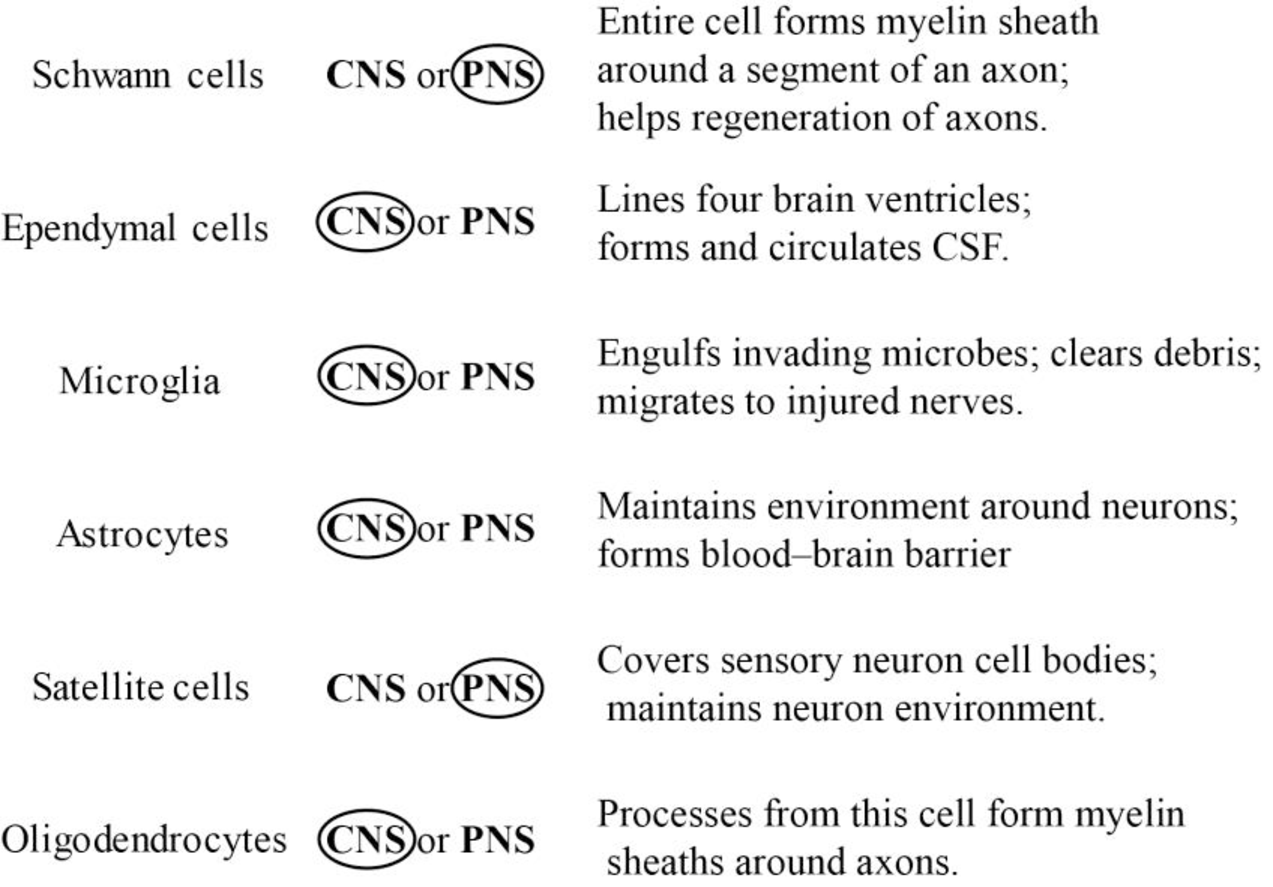
Concept explainers
The nervous system is composed of two components, which includes the central nervous system and the peripheral nervous system. The central nervous system includes the brain and the spinal cord, whereas the peripheral nervous system includes the motor and the sensory receptors. The brain is composed of nerve tissues that are protected within the skull. The major functions of the brain include processing sensory information, releasing hormones, and regulating blood pressure and breathing.
Answer to Problem 1.1BGL

Explanation of Solution
Schwann cell:
The Schwann cell is a glial cell that plays an important role in supporting the PNS. The Schwann cell, also termed as neurilemma cell, is a type of nervous tissue cell in PNS involved in producing the myelin sheath around the neuronal axons and also helps in regenerating the axons.
Ependymal cell:
The ependymal cell is a neuronal support cell, known as neuroglia, which forms the epithelial lining of the ventricles present in the brain and also the central canal of the spinal cord. Moreover, the ependymal cells give rise to the epithelial layer that encircles the choroid plexus. The choroid plexus is a collection of blood vessels that exist in the lateral ventricle walls. Cilia, present in the ventricles of the ependymal cell, help in influencing the cerebrospinal fluid direction and also bring nutrients and other substances to the neuron.
Microglia:
Microglia is a type of neuroglial cell that supports the CNS as it functions as an immune cell. The microglial cell is the smallest cell of all the neuroglia. Its main role is to mediate the immune response in the CNS by acting as macrophage, removing dead neurons, and cellular debris from the nervous tissue through the phagocytosis process.
Astrocytes:
Astrocytes, also termed as astroglia, which is characterized by star-shaped glial cells present in the brain and the spinal cord. It performs numerous functions, like axon guidance, synaptic support, controls blood-brain barrier, and also controls the blood flow. In addition, astrocytes are majorly responsible for homeostasis of the CNS.
Satellite cell:
The satellite cell, also termed as muscle stem cell or myosatellite cell, is a multipotent, flattened cell that usually exists in the ganglia (sympathetic ganglia, parasympathetic ganglia, and sensory ganglia) of the PNS. It encompasses a small amount of cytoplasm present in the mature muscle. The satellite cell plays a major role in regulating and stabilizing the environment around ganglion cell bodies.
Oligodendrocytes:
Oligodendrocyte is a type of neuroglia that supports the CNS by providing support and insulation to axons. The oligodendrocytes create an isolating sheath around the axons for rapid conduction of the signal. This may lead to massive conduction of electrical signals inside the axon.
Want to see more full solutions like this?
Chapter 16 Solutions
Laboratory Manual for Anatomy and Physiology, 6e Loose-Leaf Print Companion
- Ch.21 What causes patients infected with the yellow fever virus to turn yellow (jaundice)? A. low blood pressure and anemia B. excess leukocytes C. alteration of skin pigments D. liver damage in final stage of disease — What is the advantage for malarial parasites to grow and replicate in red blood cells? A. able to spread quickly B. able to avoid immune detection C. low oxygen environment for growth D. cooler area of the body for growth — Which microbe does not live part of its lifecycle outside humans? A. Toxoplasma gondii B. Cytomegalovirus C. Francisella tularensis D. Plasmodium falciparum — explain your answer thoroughlyarrow_forwardCh.22 Streptococcus pneumoniae has a capsule to protect it from killing by alveolar macrophages, which kill bacteria by… A. cytokines B. antibodies C. complement D. phagocytosis — What fact about the influenza virus allows the dramatic antigenic shift that generates novel strains? A. very large size B. enveloped C. segmented genome D. over 100 genes — explain your answer thoroughlyarrow_forwardWhat is this?arrow_forward
- Molecular Biology A-C components of the question are corresponding to attached image labeled 1. D component of the question is corresponding to attached image labeled 2. For a eukaryotic mRNA, the sequences is as follows where AUGrepresents the start codon, the yellow is the Kozak sequence and (XXX) just represents any codonfor an amino acid (no stop codons here). G-cap and polyA tail are not shown A. How long is the peptide produced?B. What is the function (a sentence) of the UAA highlighted in blue?C. If the sequence highlighted in blue were changed from UAA to UAG, how would that affecttranslation? D. (1) The sequence highlighted in yellow above is moved to a new position indicated below. Howwould that affect translation? (2) How long would be the protein produced from this new mRNA? Thank youarrow_forwardMolecular Biology Question Explain why the cell doesn’t need 61 tRNAs (one for each codon). Please help. Thank youarrow_forwardMolecular Biology You discover a disease causing mutation (indicated by the arrow) that alters splicing of its mRNA. This mutation (a base substitution in the splicing sequence) eliminates a 3’ splice site resulting in the inclusion of the second intron (I2) in the final mRNA. We are going to pretend that this intron is short having only 15 nucleotides (most introns are much longer so this is just to make things simple) with the following sequence shown below in bold. The ( ) indicate the reading frames in the exons; the included intron 2 sequences are in bold. A. Would you expected this change to be harmful? ExplainB. If you were to do gene therapy to fix this problem, briefly explain what type of gene therapy youwould use to correct this. Please help. Thank youarrow_forward
- Molecular Biology Question Please help. Thank you Explain what is meant by the term “defective virus.” Explain how a defective virus is able to replicate.arrow_forwardMolecular Biology Explain why changing the codon GGG to GGA should not be harmful. Please help . Thank youarrow_forwardStage Percent Time in Hours Interphase .60 14.4 Prophase .20 4.8 Metaphase .10 2.4 Anaphase .06 1.44 Telophase .03 .72 Cytukinesis .01 .24 Can you summarize the results in the chart and explain which phases are faster and why the slower ones are slow?arrow_forward
- Can you circle a cell in the different stages of mitosis? 1.prophase 2.metaphase 3.anaphase 4.telophase 5.cytokinesisarrow_forwardWhich microbe does not live part of its lifecycle outside humans? A. Toxoplasma gondii B. Cytomegalovirus C. Francisella tularensis D. Plasmodium falciparum explain your answer thoroughly.arrow_forwardSelect all of the following that the ablation (knockout) or ectopoic expression (gain of function) of Hox can contribute to. Another set of wings in the fruit fly, duplication of fingernails, ectopic ears in mice, excess feathers in duck/quail chimeras, and homeosis of segment 2 to jaw in Hox2a mutantsarrow_forward
 Human Anatomy & Physiology (11th Edition)BiologyISBN:9780134580999Author:Elaine N. Marieb, Katja N. HoehnPublisher:PEARSON
Human Anatomy & Physiology (11th Edition)BiologyISBN:9780134580999Author:Elaine N. Marieb, Katja N. HoehnPublisher:PEARSON Biology 2eBiologyISBN:9781947172517Author:Matthew Douglas, Jung Choi, Mary Ann ClarkPublisher:OpenStax
Biology 2eBiologyISBN:9781947172517Author:Matthew Douglas, Jung Choi, Mary Ann ClarkPublisher:OpenStax Anatomy & PhysiologyBiologyISBN:9781259398629Author:McKinley, Michael P., O'loughlin, Valerie Dean, Bidle, Theresa StouterPublisher:Mcgraw Hill Education,
Anatomy & PhysiologyBiologyISBN:9781259398629Author:McKinley, Michael P., O'loughlin, Valerie Dean, Bidle, Theresa StouterPublisher:Mcgraw Hill Education, Molecular Biology of the Cell (Sixth Edition)BiologyISBN:9780815344322Author:Bruce Alberts, Alexander D. Johnson, Julian Lewis, David Morgan, Martin Raff, Keith Roberts, Peter WalterPublisher:W. W. Norton & Company
Molecular Biology of the Cell (Sixth Edition)BiologyISBN:9780815344322Author:Bruce Alberts, Alexander D. Johnson, Julian Lewis, David Morgan, Martin Raff, Keith Roberts, Peter WalterPublisher:W. W. Norton & Company Laboratory Manual For Human Anatomy & PhysiologyBiologyISBN:9781260159363Author:Martin, Terry R., Prentice-craver, CynthiaPublisher:McGraw-Hill Publishing Co.
Laboratory Manual For Human Anatomy & PhysiologyBiologyISBN:9781260159363Author:Martin, Terry R., Prentice-craver, CynthiaPublisher:McGraw-Hill Publishing Co. Inquiry Into Life (16th Edition)BiologyISBN:9781260231700Author:Sylvia S. Mader, Michael WindelspechtPublisher:McGraw Hill Education
Inquiry Into Life (16th Edition)BiologyISBN:9781260231700Author:Sylvia S. Mader, Michael WindelspechtPublisher:McGraw Hill Education





